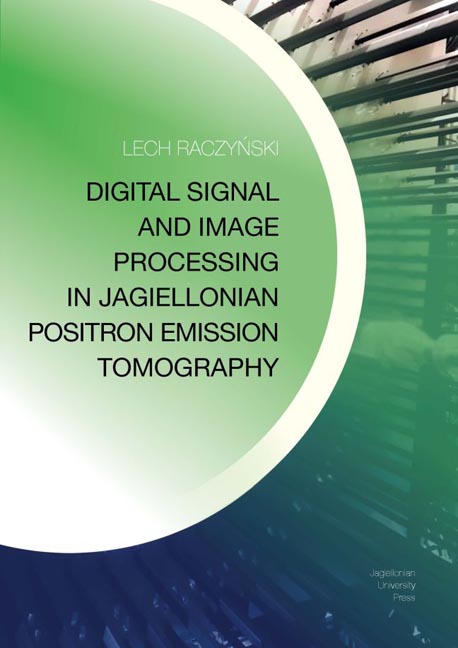Book contents
- Frontmatter
- Dedication
- Acknowledgements
- Contents
- Abbreviations
- Preface
- 1 Introduction
- 2 Positron Emission Tomography
- 3 Algorithmic background
- 4 Low-level data processing in Jagiellonian PET
- 5 High-level data processing in Jagiellonian PET
- 6 Results
- 7 Conclusions and summary
- Appendix
- References
- Miscellaneous Endmatter
2 - Positron Emission Tomography
Published online by Cambridge University Press: 13 October 2023
- Frontmatter
- Dedication
- Acknowledgements
- Contents
- Abbreviations
- Preface
- 1 Introduction
- 2 Positron Emission Tomography
- 3 Algorithmic background
- 4 Low-level data processing in Jagiellonian PET
- 5 High-level data processing in Jagiellonian PET
- 6 Results
- 7 Conclusions and summary
- Appendix
- References
- Miscellaneous Endmatter
Summary
The first demonstration of PET technique for medical imaging use was given in early 1950s by Brownell and Burnham. This was an inspiration for the concept of emission tomography used to visualize functional processes in the body in the late 1950s. The first 3-dimensional PET detector, called PC-1, was developed at the Massachusetts General Hospital and completed in 1969. This PET device comprised two planar opposed arrays of crystal scintillators [23]. In 1973 Robertson and his co-workers built the first ring PET scanner, which consisted of 32 detectors [24]. The cylindrical array of detectors has soon become the prototype of the current shape of PET [25].
The fundamental requirement that comes together with the development of the PET technology was to create radiopharmaceutical tracers that could be administered safely to the patient’s body. Currently, the most important radiopharmaceutical in PET examinations is fludeoxy- D-glucose (18F-FDG) [26]. 18F-FDG is an analog of glucose used for cellular metabolism having the hydroxyl group replaced by radionuclide 18F. Radionuclide 18F is produced in a cyclotron and has a relatively long half-life, about 110 min, that allows its supply to remote places. Similarly as glucose, 18F-FDG is absorbed by brain or kidney cells, and what is most important, by the cancer cells presenting abnormally high metabolism in comparison to the healthy organs. Therefore, PET imaging presents the distribution of glucose consumption by the cells and an overall cellular activity in the patient body.
Radionuclides are unstable due to the unsuitable composition of neutrons and protons and, therefore, decay by emission of radiation. When a radionuclide is proton rich, as in the case of 18F, it decays by the emission of a positron (β+) along with a neutrino (v):
For instance, the scheme for positron decay from 18F is:
The stability of radionuclide is achieved by converting a proton (11 p+) in the nucleus to a neutron (1 0 n). Since a daughter nucleus is one atomic number smaller than a parent nucleus, one of the orbital electrons has to be ejected from the atom. As both an electron and β+ are emitted in the decay described in Eq. (2.1), the right-hand side of this formula has to be at least two electron mass more than the left-hand side, i.e., 2 × 511 keV = 1022 keV. The energy beyond 1022 keV is shared as kinetic energy by β+ and a neutrino.
- Type
- Chapter
- Information
- Publisher: Jagiellonian University PressPrint publication year: 2021



